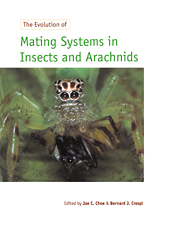Book contents
- Frontmatter
- Contents
- Contributors
- Acknowledgements
- Introduction
- 1 Evolutionary perspectives on insect mating
- 2 Sexual selection by cryptic female choice in insects and arachnids
- 3 Natural and sexual selection components of odonate mating patterns
- 4 Sexual selection in resource defense polygyny: lessons from territorial grasshoppers
- 5 Reproductive strategies of the crickets (Orthoptera: Gryllidae)
- 6 The evolution of edible ‘sperm sacs’ and other forms of courtship feeding in crickets, katydids and their kin (Orthoptera: Ensifera)
- 7 The evolution of mating systems in the Zoraptera: mating variations and sexual conflicts
- 8 The evolution of water strider mating systems: causes and consequences of sexual conflicts
- 9 Multiple mating, sperm competition, and cryptic female choice in the leaf beetles (Coleoptera: Chrysomelidae)
- 10 Firefly mating ecology, selection and evolution
- 11 Modern mating systems in archaic Holometabola: sexuality in neuropterid insects
- 12 Mating systems of parasitoid wasps
- 13 Fig–associated wasps: pollinators and parasites, sex–ratio adjustment and male polymorphism, population structure and its consequences
- 14 Evolution of mate–signaling in moths: phylogenetic considerations and predictions from the asymmetric tracking hypothesis
- 15 Sexual dimorphism, mating systems and ecology in butterflies
- 16 Lek behavior of insects
- 17 Mate choice and species isolation in swarming insects
- 18 Function and evolution of antlers and eye stalks in flies
- 19 Sex via the substrate: mating systems and sexual selection in pseudoscorpions
- 20 Jumping spider mating strategies: sex among cannibals in and out of webs
- 21 Sexual conflict and the evolution of mating systems
- Organism index
- Subject index
2 - Sexual selection by cryptic female choice in insects and arachnids
Published online by Cambridge University Press: 03 May 2010
- Frontmatter
- Contents
- Contributors
- Acknowledgements
- Introduction
- 1 Evolutionary perspectives on insect mating
- 2 Sexual selection by cryptic female choice in insects and arachnids
- 3 Natural and sexual selection components of odonate mating patterns
- 4 Sexual selection in resource defense polygyny: lessons from territorial grasshoppers
- 5 Reproductive strategies of the crickets (Orthoptera: Gryllidae)
- 6 The evolution of edible ‘sperm sacs’ and other forms of courtship feeding in crickets, katydids and their kin (Orthoptera: Ensifera)
- 7 The evolution of mating systems in the Zoraptera: mating variations and sexual conflicts
- 8 The evolution of water strider mating systems: causes and consequences of sexual conflicts
- 9 Multiple mating, sperm competition, and cryptic female choice in the leaf beetles (Coleoptera: Chrysomelidae)
- 10 Firefly mating ecology, selection and evolution
- 11 Modern mating systems in archaic Holometabola: sexuality in neuropterid insects
- 12 Mating systems of parasitoid wasps
- 13 Fig–associated wasps: pollinators and parasites, sex–ratio adjustment and male polymorphism, population structure and its consequences
- 14 Evolution of mate–signaling in moths: phylogenetic considerations and predictions from the asymmetric tracking hypothesis
- 15 Sexual dimorphism, mating systems and ecology in butterflies
- 16 Lek behavior of insects
- 17 Mate choice and species isolation in swarming insects
- 18 Function and evolution of antlers and eye stalks in flies
- 19 Sex via the substrate: mating systems and sexual selection in pseudoscorpions
- 20 Jumping spider mating strategies: sex among cannibals in and out of webs
- 21 Sexual conflict and the evolution of mating systems
- Organism index
- Subject index
Summary
ABSTRACT
Females can have important, but often underestimated effects on the likelihood that any given copulation will result in fertilization of their eggs. Examples of at least 15 different processes that occur during or after intromission, and in which females can selectively favor one male's chances of paternity over those of another, are given for insects and arachnids.
Two general phenomena suggest that such ‘cryptic’ female choice is not a rare biological curiosity, but rather a widespread and common phenomenon. Male courtship behavior in insects and spiders often (probably usually) begins or continues after intromission has occurred; the most likely explanation of this otherwise paradoxical behavior is that it serves to influence cryptic female choice. In addition, male seminal products in insects and ticks commonly influence several aspects of female reproductive physiology. Several kinds of evidence indicate that these male products have evolved under sexual selection, usually as triggering mechanisms rather than as nutrients. They may constitute ‘chemical genitalia’ that influence cryptic female choice.
Several widely held ideas about sexual selection and courtship should be modified to take into account the fact that females are less passive in male–female interactions than has previously been supposed.
- Type
- Chapter
- Information
- The Evolution of Mating Systems in Insects and Arachnids , pp. 32 - 57Publisher: Cambridge University PressPrint publication year: 1997
- 50
- Cited by

